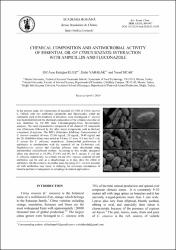CHEMICAL COMPOSITION AND ANTIMICROBIAL ACTIVITY OF ESSENTIAL OIL OF CITRUS SINENSIS: INTERACTION WITH AMPICILLIN AND FLUCONAZOLE
Künye
Eliuz, E. E., Yabalak, E., & Sicak, Y. (2020). Chemical composition and antimicrobial activity of essential oil of Citrus sinensis: interaction with ampicillin and flucanonazole. Rev Roum Chim, 65, 899-907.Özet
In the present study, the interactions of essential oil (EO) of Citrus sinensis L. Osbeck with two antibiotics (ampicillin and fluconazole), which are commonly used in the treatment of infections, were investigated. C. sinensis was hydrodistilled and the chemical composition of the obtained essential oil was identified by GC-MS (Gas Chromatography-Mass Spectrometry) analyses. The most representative compound of all obtained 18 compounds was d-limonene followed by the other major components such as linalool, alpha-terpineol, beta-myrcene. The MICs (Minimum Inhibitory Concentration) of C. sinensis essential oil were 152.06 mg/mL, 20 mg/mL, 54.41 mg/mL and the IZs (Inhibition Zone) were noted as 3.4 mm, 3.3 mm, 8.3 mm for E. coli, S. aureus for C. albicans, respectively. Antimicrobial performance of antibiotics in combinations with the essential oil on Escherichia coli, Staphylococcus aureus and Candida albicans were determined using antimicrobial checkerboard method. According to this model, antagonist effect was observed as 14.29%, 57.14% and 0% for S. aureus, E. coli and C. albicans, respectively. As a result, the use of C. sinensis essential oil with antibiotics can be seen as a disadvantage as it may slow the effect of antibiotics. On the contrary, in another case, the using of C. sinensis essential oil with antibiotics may cause to delaying the resistance mechanisms of bacteria and turn of antagonism to advantage in clinical applications.
Kaynak
REVUE ROUMAINE DE CHIMIECilt
65Sayı
10Bağlantı
http://revroum.lew.ro/wp-content/uploads/2020/10/Art%2005.pdfhttps://hdl.handle.net/20.500.12809/9475


















